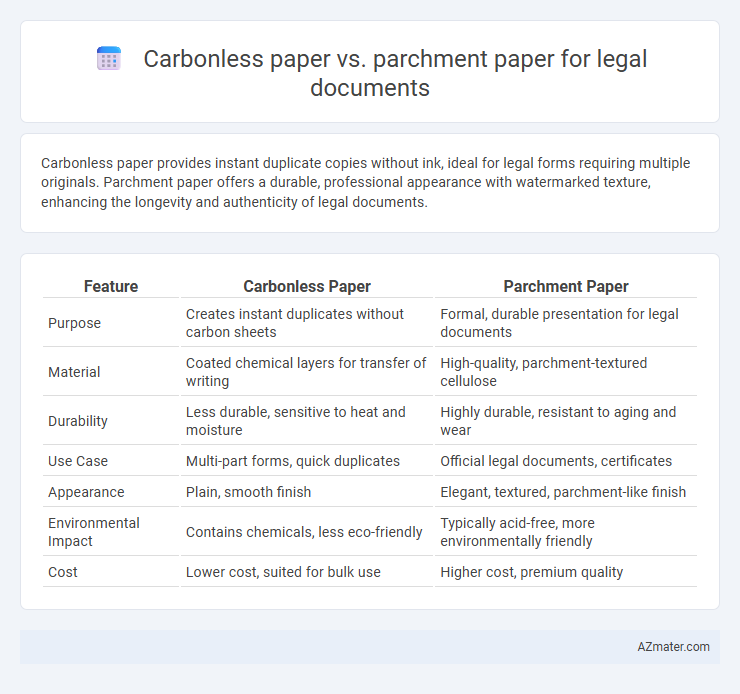Carbonless paper provides instant duplicate copies without ink, ideal for legal forms requiring multiple originals. Parchment paper offers a durable, professional appearance with watermarked texture, enhancing the longevity and authenticity of legal documents.
Table of Comparison
| Feature | Carbonless Paper | Parchment Paper |
|---|---|---|
| Purpose | Creates instant duplicates without carbon sheets | Formal, durable presentation for legal documents |
| Material | Coated chemical layers for transfer of writing | High-quality, parchment-textured cellulose |
| Durability | Less durable, sensitive to heat and moisture | Highly durable, resistant to aging and wear |
| Use Case | Multi-part forms, quick duplicates | Official legal documents, certificates |
| Appearance | Plain, smooth finish | Elegant, textured, parchment-like finish |
| Environmental Impact | Contains chemicals, less eco-friendly | Typically acid-free, more environmentally friendly |
| Cost | Lower cost, suited for bulk use | Higher cost, premium quality |
Understanding Carbonless Paper and Parchment Paper
Carbonless paper consists of micro-encapsulated dye or ink on its back that transfers writing pressure from the top sheet to subsequent sheets without the need for carbon paper, making it ideal for duplicate or triplicate legal documents requiring immediate copies. Parchment paper, traditionally made from treated animal skin but now often a cellulose-based paper with a distinct texture and durability, serves as a formal, archival-quality medium favored for preserving official legal documents due to its resistance to aging and tampering. Understanding these materials highlights that carbonless paper prioritizes functionality for multi-part forms, while parchment paper emphasizes longevity and authenticity in legal documentation.
Key Differences in Composition and Manufacturing
Carbonless paper contains micro-encapsulated dye or ink that reacts chemically when pressure is applied, creating instant copies without carbon sheets, making it ideal for multi-part legal forms. Parchment paper is produced from cellulose fibers with a mechanical or chemical process that gives it a durable, non-transparent, and slightly textured finish, often used for official or archival legal documents due to its aesthetic and longevity. The primary difference lies in carbonless paper's coating designed for transfer and duplication versus parchment paper's fibrous structure emphasizing durability and presentation.
Legal Document Requirements: What Matters Most?
Legal documents require materials that ensure clarity, permanence, and authenticity to meet stringent legal standards. Carbonless paper offers instant duplicate copies without the risk of smudging, essential for contracts and notarized forms, while parchment paper provides a durable, archival-quality medium valued for its resistance to aging and tampering. The choice hinges on whether immediate duplicate records or long-term preservation and formal presentation are the primary legal document priorities.
Durability and Longevity Comparison
Carbonless paper offers moderate durability suitable for short-term legal document copies but may fade or degrade over time due to its chemical coating. Parchment paper, made from treated animal skin or durable fibers, provides superior longevity and resistance to wear, making it ideal for preserving original legal documents. For long-term archival purposes, parchment paper stands out as the more durable and lasting option compared to carbonless paper.
Archival Quality: Preserving Legal Records
Carbonless paper offers clear, immediate duplicate copies without embossing but may degrade faster over time due to chemical layers, impacting long-term preservation of legal records. Parchment paper, known for its durability and resistance to aging, ensures superior archival quality by maintaining document integrity over decades, making it ideal for preserving important legal documents. Legal professionals often prefer parchment paper when prioritizing longevity and historical preservation in legal archives.
Security Features: Preventing Fraud and Tampering
Carbonless paper for legal documents embeds micro-encapsulated dye that reacts chemically upon pressure, creating indelible marks that resist tampering and ensure document authenticity. Parchment paper offers a unique texture and fiber composition difficult to replicate, providing a physical barrier against unauthorized alterations and enhancing security through its naturally durable and distinctive appearance. Combining these materials can significantly reduce fraud risks by making legal documents harder to counterfeit or modify without detection.
Writing Experience and Readability
Carbonless paper offers a smooth writing experience ideal for creating multiple copies of legal documents without the need for ink transfer, enhancing efficiency and reducing smudging. Parchment paper provides a textured surface that elevates the document's aesthetic and durability, improving readability with its distinctive background and opacity. For legal documents requiring multiple originals and clear legibility, carbonless paper excels in practical use, while parchment paper enhances presentation and archival quality.
Cost-Effectiveness for Legal Practices
Carbonless paper offers a cost-effective solution for legal practices by eliminating the need for multiple copies and reducing printing expenses, making it ideal for creating instant duplicates of legal documents. Parchment paper, while providing a distinctive and professional appearance, tends to be more expensive and less practical for everyday legal use due to higher material costs. Legal firms aiming to optimize budget without sacrificing efficiency often prefer carbonless paper for routine documentation and use parchment paper selectively for formal, high-value contracts or certificates.
Environmental Impact and Sustainability
Carbonless paper generates fewer chemical wastes than traditional carbon paper but still involves coatings that can hinder recycling processes. Parchment paper, often made from cellulose fibers and treated for durability, is typically more biodegradable and compostable, offering a lower environmental footprint. For legal documents requiring multiple copies, parchment paper provides a sustainable option when paired with digital duplication methods, minimizing chemical use and waste.
Choosing the Right Paper for Legal Documents
Choosing the right paper for legal documents depends on the purpose and required durability; carbonless paper is ideal for creating multiple copies without ink smudging, enhancing efficiency in contract signing and record keeping. Parchment paper, known for its high-quality, textured finish, conveys a formal and professional appearance, making it suitable for official certificates and archival documents. Legal professionals must assess whether immediate duplication or long-term preservation is the priority when selecting between carbonless and parchment paper.

Infographic: Carbonless paper vs Parchment paper for Legal document
 azmater.com
azmater.com